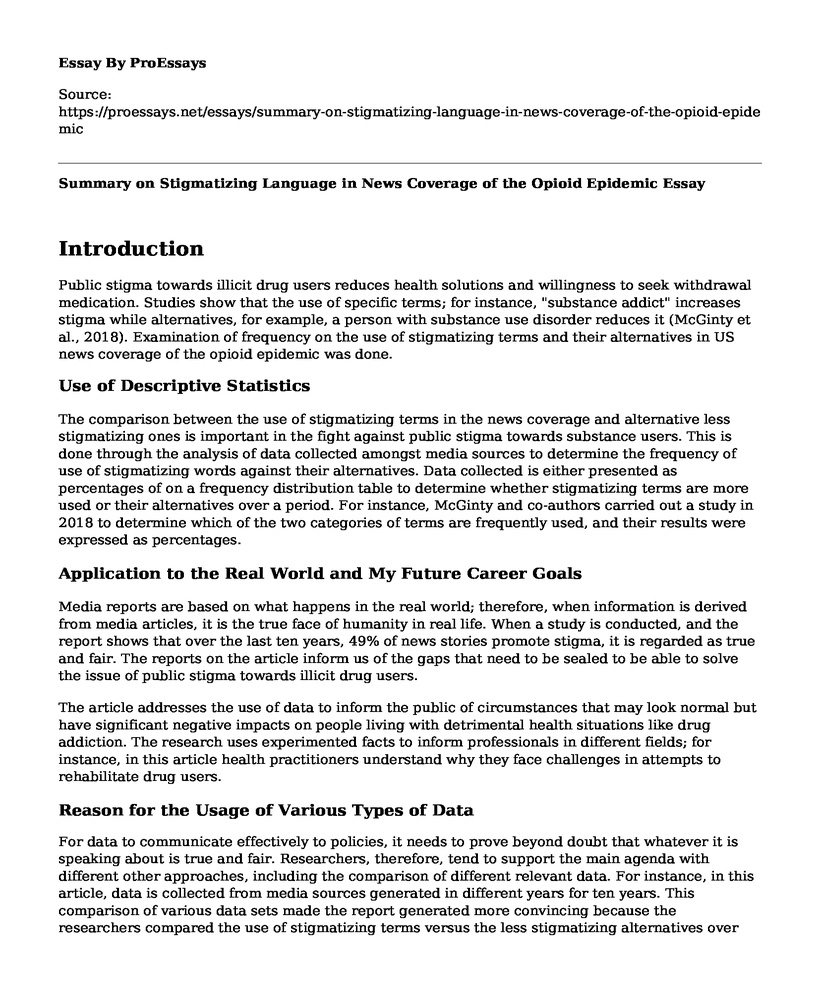Introduction
Public stigma towards illicit drug users reduces health solutions and willingness to seek withdrawal medication. Studies show that the use of specific terms; for instance, "substance addict" increases stigma while alternatives, for example, a person with substance use disorder reduces it (McGinty et al., 2018). Examination of frequency on the use of stigmatizing terms and their alternatives in US news coverage of the opioid epidemic was done.Use of Descriptive Statistics
The comparison between the use of stigmatizing terms in the news coverage and alternative less stigmatizing ones is important in the fight against public stigma towards substance users. This is done through the analysis of data collected amongst media sources to determine the frequency of use of stigmatizing words against their alternatives. Data collected is either presented as percentages of on a frequency distribution table to determine whether stigmatizing terms are more used or their alternatives over a period. For instance, McGinty and co-authors carried out a study in 2018 to determine which of the two categories of terms are frequently used, and their results were expressed as percentages.
Application to the Real World and My Future Career Goals
Media reports are based on what happens in the real world; therefore, when information is derived from media articles, it is the true face of humanity in real life. When a study is conducted, and the report shows that over the last ten years, 49% of news stories promote stigma, it is regarded as true and fair. The reports on the article inform us of the gaps that need to be sealed to be able to solve the issue of public stigma towards illicit drug users.
The article addresses the use of data to inform the public of circumstances that may look normal but have significant negative impacts on people living with detrimental health situations like drug addiction. The research uses experimented facts to inform professionals in different fields; for instance, in this article health practitioners understand why they face challenges in attempts to rehabilitate drug users.
Reason for the Usage of Various Types of Data
For data to communicate effectively to policies, it needs to prove beyond doubt that whatever it is speaking about is true and fair. Researchers, therefore, tend to support the main agenda with different other approaches, including the comparison of different relevant data. For instance, in this article, data is collected from media sources generated in different years for ten years. This comparison of various data sets made the report generated more convincing because the researchers compared the use of stigmatizing terms versus the less stigmatizing alternatives over ten years. Further, the comparison should be able to either communicate a consistency in variations of these two variables (stigmatizing and less stigmatizing terms) or register inconsistency, and that is why we take a duration span of 10 years.Conclusion
In conclusion, it is important to note how effective data communication and the need to advance scientific research with data-based experiments. From the article of reference, we have seen how public stigma is enhanced against substance users. Use of stigmatizing terms is on the rise, and we need to find solutions to lower the level of public stigma against these people using substances. Data tries to communicate to its users about what is happening and why it is happening; therefore if policies are not executed to solve these cases, the objective of generating the data is not met.
References
McGinty, E. E., Stone, E. M., Kennedy-Hendricks, A., & Barry, C. L. (2019). Stigmatizing language in news media coverage of the opioid epidemic: Implications for public health. Preventive medicine, 124, 110-114. doi.org/10.1016/j.ypmed.2019.03.018
Pollack, H. A. (2019). Person-first language and addiction: A means to an end, not an end in itself. Preventive medicine, 124, 115-116. DOI: 10.1016/j.ypmed.2019.04.015
Rajesh, K., Crijns, T. J., & Ring, D. (2019). Themes in published obituaries of people who have died of opioid overdose. Journal of addictive diseases, 1-6. https://doi.org/10.1080/10550887.2019.1639485
Cite this page
Summary on Stigmatizing Language in News Coverage of the Opioid Epidemic. (2022, Feb 25). Retrieved from https://proessays.net/essays/summary-on-stigmatizing-language-in-news-coverage-of-the-opioid-epidemic
If you are the original author of this essay and no longer wish to have it published on the ProEssays website, please click below to request its removal:
- Essay Sample on Pros and Cons of Vaccinations
- Children With Diabetes Have Poor Academic Performance Essay
- Essay Sample on Personal Reflection on Dementia
- Patient Care Assistant Paper Example
- Social Workers: Rules, Strategies & Challenges for Social Welfare - Essay Sample
- Nursing Interventions for Addictions: Advice, Counseling & Strategies - Research Paper
- Paper Example on Adapting to Working from Home in a Post-COVID World







